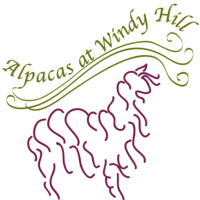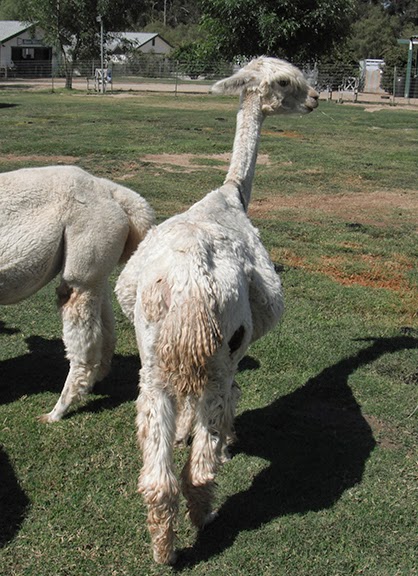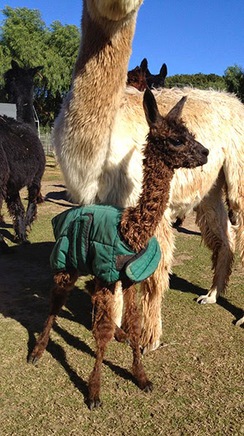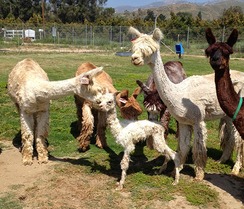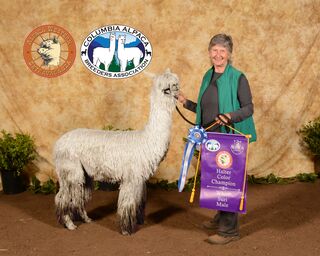CRIA SEASON IS HERE-- Are you ready?
Monday, April 28, 2014
Pretty exciting times coming up… CRIA SEASON IS HERE!
Due Dates
Remember that due dates are like they are with people. Crias comes when they are really ready, not when the calendar says they will. In fact, at this time of year in California, anyway, they tend to run late. Our vet says not to worry until 2 weeks past a year before you think about intervention. A healthy womb is always better than the outside environment for that last little bit of gestation. We try not to bug the moms about anything in the last 60 days before the due date, keeping stress to a minimum. Toenails can wait until after the cria is born. It’s really hard to wait when they go over their due date!
Feed
We usually feed Mazuri Alpaca Growth and Repro pellets for about 3 weeks before the female is due. We sometimes use lactation herbs as well, but our girls seem to do just fine now with just the pellets. Developed by Dr. Norm Evans, Growth and Repro gives the late term mom the extra "oomph" she needs in the last 3 weeks of her pregnancy when the baby is making big demands on her resources. It helps her with milk production and keeps her weight from dropping rapidly when she starts lactating.
Herbs
If you have a female who you know needs an extra boost with her milk, we have used Dr. Pollard’s Lactation Herbs and Riley’s Lactation Formula mixed with the Growth and Repro. You would only need to give her about 1/4 cup a day each for the last little bit of her pregnancy, and continue for the 1st 3 weeks after she delivers the cria. It should help her peak and hold her milk production by about 3 weeks postpartum.
Coats
You should probably have a couple of cria coats in case it's cold when they are born. Being too cold is something you really need to watch, because if they are too cold they can't get up and nurse. If the cria is born at 6 am, it could be in trouble if it's really cold in the morning. Rule of thumb: if you need a jacket, the cria needs a jacket. Newborns have very little ability to regulate their internal temperature, and they are born wet.
Antiseptic Solution
You will need Novalsan or Betadine solution, diluted 1:1 to dip the navel in after birth. Bacteria love to crawl up those open blood vessels, so we dip once and sometimes twice. The solution helps dry up the umbilicous. If the stump is really short, watch carefully for any swelling, and call the vet if you see it happening.
Warmth
Have a supply of dry towels to wrap the cria in when it’s born, and do some gentle rubbing to help it dry off if it's cold. You can peel the membrane off if you want to, but it's not really necessary. I’m always anxious to examine the fleece, but there is time enough for that when the cria is dry. You might need a small heater or hair dryer to warm the baby up if it's too cold. If it's a nice warm day, you're probably not going to have to do too much.
Energy
If the cria is slow to get up, it's usually a good idea to roll it onto its chest in a sternal position so that it can breathe more easily. If you would be chilly in wet clothes, put a jacket on the baby. If the wind is blowing, take it inside for awhile. If it just seems a little lack-luster in its behavior, you can try putting Karo syrup on your finger and rubbing it on the cria's gums. It's amazing how fast it absorbs! The sugar gives them a little shot of energy, and can even stimulate the sucking reflex. We also keep a supply of goat’s milk around, just in case the cria is too weak to get up at first, or mom’s milk takes a few hours to come in. If the little guy won’t take a bottle, you can syringe the milk down the cria’s throat (remember to warm it up a little first), or in extreme cases, use a feeding tube (ask your vet for directions on how to properly use the feeding tube).
Bonding
Be prepared to do NOTHING.
If you see mom in labor and are tempted to help, sit on your hands another 20 minutes and watch.
If the cria looks a little sleepy when it’s born, it probably needs a nap. Getting born is hard work!
If the cria falls on its face 4 or 5 times while trying to get up, cheer her on, but try to stay out of mom’s way. That’s all normal.
If the cria looks wobbly when it stands up and you think it will never find the udder, go for a walk around the ranch before you try to help.
Alpacas are really good moms—even the newbies. The last thing you want is for that cria to ID you as its mother and be confused! Those first few hours are essential to a cria growing up with a healthy and proper self-image in order to avoid over-"friendliness" and problems down the line. Dip the navel and back away. Maybe, just maybe, you can wait until the next day to weigh the little cutie so she has more time with mom. Weights are good to have, but not essential on Day 1, in my opinion. Sometimes you have to intervene to be sure the cria is healthy, but that should be the exception, not the rule.
Enjoy!
Mostly, just enjoy your time observing the new cria. What a wonder it is to be a part of the birth of a new creature. A miracle! Like opening a Christmas gift! It’ll always be a surprise—different gender, different color, different markings—you never really know what to expect! But it’s infinitely fascinating and fun to meet this new member of your herd. I think crias are the best part of raising alpacas!
Questions?
How can we help you with what to expect as your dams approach birthing? Please call or email me if you have questions. We’ve witnessed literally 100’s of births here at Windy Hill. And I used to teach 4th grade, so I have a California Credential in Answering Questions! We look forward to hearing from you.
Cindy
Cindy Harris ~ Alpacas at Windy Hill ~ www.alpacalink.com
[email protected] ~ (805) 907-5162
Alpaca Ownership with a Safety Net-- How can we help YOU?
Due Dates
Remember that due dates are like they are with people. Crias comes when they are really ready, not when the calendar says they will. In fact, at this time of year in California, anyway, they tend to run late. Our vet says not to worry until 2 weeks past a year before you think about intervention. A healthy womb is always better than the outside environment for that last little bit of gestation. We try not to bug the moms about anything in the last 60 days before the due date, keeping stress to a minimum. Toenails can wait until after the cria is born. It’s really hard to wait when they go over their due date!
Feed
We usually feed Mazuri Alpaca Growth and Repro pellets for about 3 weeks before the female is due. We sometimes use lactation herbs as well, but our girls seem to do just fine now with just the pellets. Developed by Dr. Norm Evans, Growth and Repro gives the late term mom the extra "oomph" she needs in the last 3 weeks of her pregnancy when the baby is making big demands on her resources. It helps her with milk production and keeps her weight from dropping rapidly when she starts lactating.
Herbs
If you have a female who you know needs an extra boost with her milk, we have used Dr. Pollard’s Lactation Herbs and Riley’s Lactation Formula mixed with the Growth and Repro. You would only need to give her about 1/4 cup a day each for the last little bit of her pregnancy, and continue for the 1st 3 weeks after she delivers the cria. It should help her peak and hold her milk production by about 3 weeks postpartum.
Coats
You should probably have a couple of cria coats in case it's cold when they are born. Being too cold is something you really need to watch, because if they are too cold they can't get up and nurse. If the cria is born at 6 am, it could be in trouble if it's really cold in the morning. Rule of thumb: if you need a jacket, the cria needs a jacket. Newborns have very little ability to regulate their internal temperature, and they are born wet.
Antiseptic Solution
You will need Novalsan or Betadine solution, diluted 1:1 to dip the navel in after birth. Bacteria love to crawl up those open blood vessels, so we dip once and sometimes twice. The solution helps dry up the umbilicous. If the stump is really short, watch carefully for any swelling, and call the vet if you see it happening.
Warmth
Have a supply of dry towels to wrap the cria in when it’s born, and do some gentle rubbing to help it dry off if it's cold. You can peel the membrane off if you want to, but it's not really necessary. I’m always anxious to examine the fleece, but there is time enough for that when the cria is dry. You might need a small heater or hair dryer to warm the baby up if it's too cold. If it's a nice warm day, you're probably not going to have to do too much.
Energy
If the cria is slow to get up, it's usually a good idea to roll it onto its chest in a sternal position so that it can breathe more easily. If you would be chilly in wet clothes, put a jacket on the baby. If the wind is blowing, take it inside for awhile. If it just seems a little lack-luster in its behavior, you can try putting Karo syrup on your finger and rubbing it on the cria's gums. It's amazing how fast it absorbs! The sugar gives them a little shot of energy, and can even stimulate the sucking reflex. We also keep a supply of goat’s milk around, just in case the cria is too weak to get up at first, or mom’s milk takes a few hours to come in. If the little guy won’t take a bottle, you can syringe the milk down the cria’s throat (remember to warm it up a little first), or in extreme cases, use a feeding tube (ask your vet for directions on how to properly use the feeding tube).
Bonding
Be prepared to do NOTHING.
If you see mom in labor and are tempted to help, sit on your hands another 20 minutes and watch.
If the cria looks a little sleepy when it’s born, it probably needs a nap. Getting born is hard work!
If the cria falls on its face 4 or 5 times while trying to get up, cheer her on, but try to stay out of mom’s way. That’s all normal.
If the cria looks wobbly when it stands up and you think it will never find the udder, go for a walk around the ranch before you try to help.
Alpacas are really good moms—even the newbies. The last thing you want is for that cria to ID you as its mother and be confused! Those first few hours are essential to a cria growing up with a healthy and proper self-image in order to avoid over-"friendliness" and problems down the line. Dip the navel and back away. Maybe, just maybe, you can wait until the next day to weigh the little cutie so she has more time with mom. Weights are good to have, but not essential on Day 1, in my opinion. Sometimes you have to intervene to be sure the cria is healthy, but that should be the exception, not the rule.
Enjoy!
Mostly, just enjoy your time observing the new cria. What a wonder it is to be a part of the birth of a new creature. A miracle! Like opening a Christmas gift! It’ll always be a surprise—different gender, different color, different markings—you never really know what to expect! But it’s infinitely fascinating and fun to meet this new member of your herd. I think crias are the best part of raising alpacas!
Questions?
How can we help you with what to expect as your dams approach birthing? Please call or email me if you have questions. We’ve witnessed literally 100’s of births here at Windy Hill. And I used to teach 4th grade, so I have a California Credential in Answering Questions! We look forward to hearing from you.
Cindy
Cindy Harris ~ Alpacas at Windy Hill ~ www.alpacalink.com
[email protected] ~ (805) 907-5162
Alpaca Ownership with a Safety Net-- How can we help YOU?
